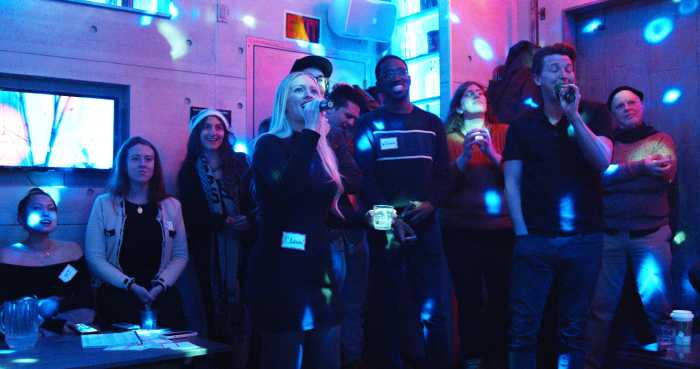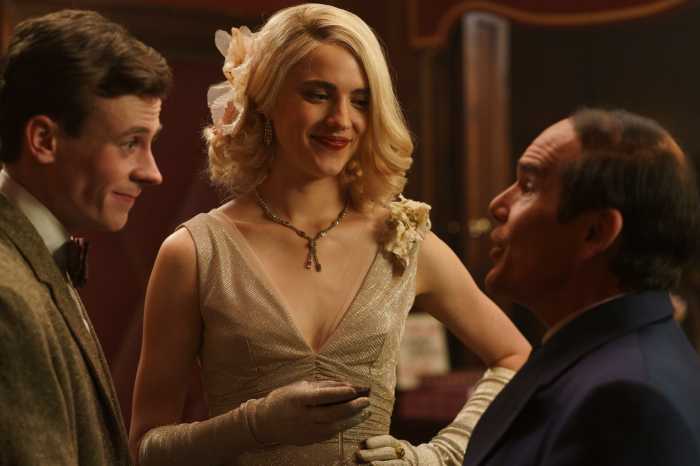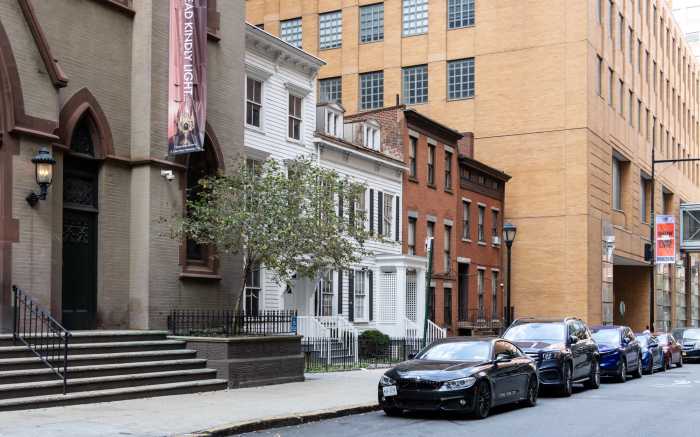
Limón Dance Company Kicks off 80th Anniversary Celebration at The Joyce Theater

The Limón Dance Company (LDC) launches celebrations of the company’s 80 history with a bold, intergenerational program that honors eight decades of revolutionary modern dance by its founder, José Limón, and amplifies the voices of today. The program runs at The Joyce Theater, 175 Eighth Avenue, NYC, from October 14-19, 2025 and features a Curtain Chat on October 15. Performances: Tue-Sat at 7:30pm, Sat & Sun at 2pm. Tickets start at $17, including fees, and are available at https://www.joyce.org/performances/172//limon-dance-company.
From José Limón’s foundational works to powerful new commissions, this celebratory engagement delves deeply into questions of masculinity, identity, queerness, and the human condition — questions Limón himself wrestled with throughout his lifetime. The program opens with a multi-generational restaging of Limón’s 1942 solo Chaconne —a poignant meditation on form, dignity, and the elevation of the male figure, featuring live music. It is followed by a new reconstruction of Limón’s The Emperor Jones (1956), a haunting portrait inspired by Eugene O’Neill’s play that explores authority, vulnerability, and the weight of self-mythology. Bridging history and innovation, the evening concludes with Jamelgos, a World Premiere from acclaimed Mexican choreographer Diego Vega Solorza. A vital voice in Latin American dance, Vega Solorza brings a personal lens shaped by his experience as a queer Mexican man. Like Limón, his work confronts the realities of its time with choreography that is personal, urgent, and unapologetic.
Chaconne (1942, José Limón)
Music: J.S. Bach, Chaconne from Partitia #2 in D Minor – Live Violinist
At the heart of the program lies an expansive staging of Limón’s Chaconne, originally choreographed as a solo in 1942 to elevate the presence of the male dancer. A meditation on form, dignity, and the elevation of the male dance figure in modern dance, Chaconne becomes a multigenerational homage in this performance — reimagined for an ensemble of former and current Limón Company dancers. Presented in celebration of The Joyce’s own history, this re-staging brings together artists who have shaped the Company across decades, honoring their contributions while reaffirming Limón’s timeless artistic mission. At this juncture of the historical canon of Limón, this performance marks the roots of a new generation as well, by giving homage to the past in order to sow new grounds for the influence of Limón.
The Emperor Jones (1956, José Limón)
Music: Heitor Villa-Lobos
Reconstruction by Dante Puleio (2025)
A gripping examination of tyranny and masculine identity, Limón’s adaptation of O’Neill’s play returns in a groundbreaking contemporary adaptation that draws out the work’s queer subtext and psychological tension. Limón’s works frequently explored the complexity of male identity and power through duets of tension and contrast. Nowhere is this more evident than in The Emperor Jones, a haunting psychological portrait inspired by O’Neill’s play. In Limón’s telling, the story of a self-made tyrant hunted down by his former subjects becomes a vehicle for examining authority, vulnerability, and the destructive weight of self-mythology. This reconstruction — the first in the work’s history to feature a mixed-gender corps — embraces contemporary design and a reimagined visual world that speaks to today’s audiences while remaining true to Limón’s emotional truth. Through updated costuming and staging, The Emperor Jones becomes not only a historical artifact but also a living, evolving work, inviting renewed reflection on race, masculinity, and the burden of power.
Jamelgos, World Premiere by Diego Vega Solorza (2025)
A powerful response to Limón’s oeuvre by one of today’s most avant-garde Mexican choreographers. This new work explores and reflects on masculinity and the inherited legacies of gender interpretation in Mexican culture. The work is intended to be a dance manifesto that conjures a choreographic landscape promising a hopeful future. In conversation with Limón’s exploration of male relationships and identities, the program will feature a world premiere by acclaimed Mexican choreographer Diego Vega Solorza, whose work currently interrogates the relationships of human beings to their environment, gender space, identity, and the subtle violence of social conditioning. A vital voice in Latin American contemporary dance, Vega Solorza brings a deeply personal yet objective vision to Limón’s themes; one that aims to be universal but is shaped by his own lived experience as a queer Mexican man navigating complex cultural landscapes. Drawing inspiration from Limón’s The Traitor, The Moor’s Pavane, and The Emperor Jones, Vega Solorza’s commission is a radical imagining — a dance that dismantles traditional notions of masculinity and power, while reflecting on the way we inhabit and transform physical and imaginary spaces. Vega Solorza’s choreography doesn’t merely respond to Limón’s legacy; it expands it, pushing the boundaries of what masculine identity can look like. This work is a bold next step in the Foundation’s mission to foster US-Mexico artistic exchange, highlighting the evolution of Limón’s influence across borders and generations. From Limón to Diego Vega Solorza, the lineage continues — deepening our understanding of gender, expression, and the shared histories that bind us. The original music score will be created by Ebe Oke, a contemporary American composer, who has a long history of blending orchestra and electronic elements. The score will reinforce the tension between traditional and modern identities.
Commissioned by the José Limón Dance Foundation. Commissioning support for the creation of a new work by Diego Vega Solorza is provided, in part, by The Joyce’s Stephen and Cathy Weinroth Fund for New Work and the Limón Innovation Fund Partners: The Howard Gilman Foundation and the Arnhold Foundation. The original music score by Ebe Oke is co-commissioned by Artis—Naples, Naples Philharmonic.
ABOUT THE ARTISTS
JOSÉ LIMÓN (Founder/Choreographer, 1908-1972) electrified the world with his dynamic masculine dancing and dramatic choreography. One of the 20th century’s most important and influential dance makers, he spent his career pioneering a new art form and fighting for its recognition. Born in Culiacán, Mexico in 1908, he moved to California in 1915, and in 1928 came to New York where he saw his first dance program. Limón enrolled in Doris Humphrey and Charles Weidman’s dance school and performed in several of their works from 1930 to 1940. In 1946, with Doris Humphrey as Artistic Director, Limón formed his own company. Over the next 25 years, he established himself and his company as a major force of 20th century dance. Limón created a total of 74 works, including The Moor’s Pavane, Concerto Grosso, and Missa Brevis.
Founded in 1946 by José Limón and Doris Humphrey, the Limón Dance Company (LDC) has been at the vanguard of American Modern dance since its inception and is considered one of the world’s greatest dance companies. Choreographer and dancer José Limón is credited with creating one of the world’s most important and enduring dance legacies— an art form responsible for the creation, growth and support of modern dance in this country. Acclaimed for its dramatic expression, technical mastery and expansive, yet nuanced movement, the Limón Dance Company illustrates the timelessness of José Limón’s work and vision. The Company’s repertory, which includes classic works in addition to new commissions from contemporary choreographers, possesses an unparalleled breadth and creates unique experiences for audiences around the world. www.limon.nyc
DIEGO VEGA SOLORZA (Choreographer) is one of Mexico’s most outstanding choreographers and dancers. He burst onto the Mexican artistic scene with a proposal that has challenged the traditional limits of dance. His trajectory positions him as a key figure in the contemporary scene and as an active agent in the reformulation of the place of the body, movement and choreography in the visual and scenic culture of the country (Mexico). His work expands towards interdisciplinarity, dialoguing with architecture, sculpture, poetry, sound, painting and other arts. Far from conforming to established canons, Diego has insisted on moving dance towards new formats of presentation and exhibition. He is also a native of Sinaloa, which establishes a symbolic and intergenerational link with José Limón. After Limón, Diego is the performing artist most associated with the legacy of Mexican architect Luis Barragán, becoming the first dancer of the 21st century to intervene choreographically in one of his spaces since José Limón in 1951. The narrative of his work is multiple, encompassing themes from rituality to masculinity. His work has been presented at international platforms such as Art Basel Miami and MUTEK Festival Japan. In addition, he has been recognized as one of the 40 most influential voices in the sexual-creative diversity scene in Mexico. This collaboration – the second with a Mexican choreographer since 2021 – offers a unique opportunity to re-examine masculinity in dance through Limón’s aesthetic lineage.
EBE OKE (Composer) is a composer and interdisciplinary artist working across sound, performance, painting, composition and visual art. Their formative years on a bird sanctuary in South Georgia (US) underpin a practice that foregrounds non-human perspectives and interrogates the structures that govern identity, access, and inclusion. Ebe’s work draws on overlooked sensory registers—such as the choreographies of animal and plant life, and the tonal language of machines and birdsong—to surface forms of resonance and affective traces that move between species and systems. These expressions invite shifts in perception and offer openings for new forms of attention, relation, and ecological attunement.
Shaped by a non-linear path, Ebe’s practice has evolved through a bespoke education, including composition lessons with Karlheinz Stockhausen, and mentorships and collaborations with artists such as AA Bronson, Brian Eno, and Laurie Anderson. Their work has been presented internationally at venues including Tate St Ives, the Serpentine Gallery in London, The Kitchen and Pioneer Works in New York, Punkt Festival in Norway, Art Basel in Switzerland, Dommune in Tokyo, and most recently, the Biogeometry Institute for the Museum of Consciousness in Cairo, Egypt.
Ebe’s debut album, SPECIES, explores themes of identity, healing, and non-human perspectives, featuring processed bird and insect sounds woven with precise programming, string arrangements, and treated vocals. Other works include FIELD, commissioned by AA Bronson for a multi-sensory installation, and DOKUMENT #2, a collaborative live album with Laurie Anderson and Brian Eno, released as limited edition vinyl in 2020. Ebe collaborates with the tech startup Wavepaths, which integrates generative music into psychedelic psychotherapy, and is currently a composer in residence at EMS in Stockholm.
The Joyce Theater Foundation (“The Joyce,” Executive Director, Linda Shelton), a non-profit organization, has proudly served the dance community for more than four decades. Under the direction of founders Cora Cahan and Eliot Feld, Ballet Tech Foundation acquired and renovated the Elgin Theater in Chelsea. Opening as The Joyce Theater in 1982, it was named in honor of Joyce Mertz, beloved daughter of LuEsther T. Mertz. It was LuEsther’s clear, undaunted vision and abundant generosity that made it imaginable and ultimately possible to build the theater. Ownership was secured by The Joyce in 2015. The theater is one of the only theaters built by dancers for dance and has provided an intimate and elegant home for over 475 U.S.-based and international companies. The Joyce has also expanded its reach beyond its Chelsea home through off-site presentations at venues ranging in scope from Lincoln Center’s David H. Koch Theater to Brooklyn’s Invisible Dog Art Center, and outdoor programming in spaces such as Hudson River Park. To further support the creation of new work, The Joyce maintains longstanding commissioning and residency programs. Local students and teachers (1st–12th grade) benefit from its school program, and family and adult audiences get closer to dance with access to artists. The Joyce’s annual season of about 48 weeks of dance includes over 300 performances for audiences of over 100,000.









